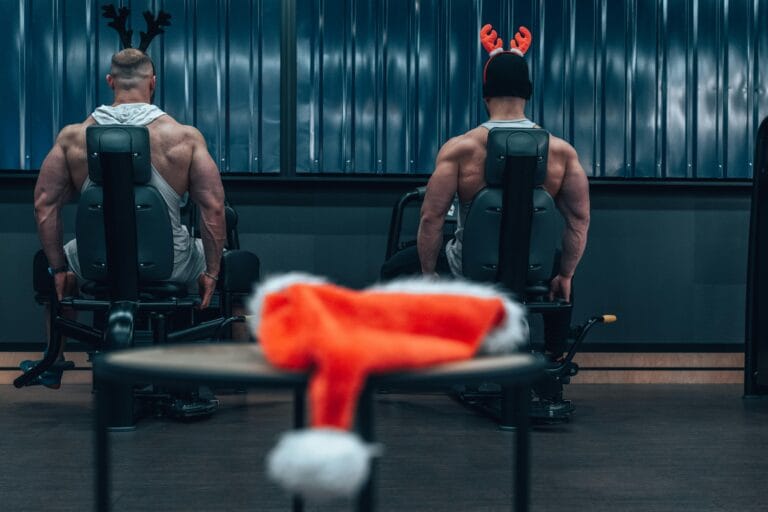FREE SHIPPING OVER $50
Fitness Over 45? These 5 ‘Healthy’ Habits Are Secretly Sabotaging Your Muscle Gains

You hit 45, and suddenly, the rules of fitness changed. The workouts that kept you lean and strong in your 20s and 30s now seem to yield diminishing returns. You’re trying harder, eating cleaner, and being more consistent than ever, yet you’re facing that frustrating reality: muscle gain is stalled, and that stubborn fat around your midsection just won’t budge.
If this sounds familiar, you’re not alone. The physiological landscape shifts dramatically as we enter our mid-40s. Hormone levels—especially testosterone and growth hormone—begin a steady decline. Our protein synthesis rates slow down, and our bodies become masters at holding onto fat while simultaneously accelerating the breakdown of muscle tissue, a process known as sarcopenia.
The biggest problem isn’t laziness or lack of effort; it’s the persistence of habits that were once effective but are now actively working against your goals. These habits, often disguised as “healthy,” are actually secretly sabotaging your muscle gains and making it incredibly difficult to maintain a strong, resilient physique.
The 5 ‘Healthy’ Habits That Kill Muscle After 45
For men and women over 45, maximizing lean muscle mass is non-negotiable for longevity, metabolic health, and injury prevention. The following five habits interrupt the delicate processes of muscle recovery and synthesis, making them the primary saboteurs of your fitness efforts.
1. Excessive, Low-Intensity Cardio (The Endless Treadmill Trap)
After 45, many people default to long, slow runs or endless sessions on the elliptical machine, believing that more time spent doing cardio equals more fat loss and better health. While cardiovascular exercise is essential, relying too heavily on low-intensity steady-state (LISS) cardio, especially at the expense of strength training, is a huge mistake for muscle maintenance.
- The Sabotage: When you spend hours performing moderate-intensity, repetitive motion, you signal to your body that you need endurance, not power or size. Chronically elevated cortisol (the stress hormone) from prolonged exercise can actively break down muscle tissue to use for energy. This is a catabolic state, exactly the opposite of the anabolic (muscle-building) state you need to fight sarcopenia.
- The Counter-Strategy: Reduce your LISS cardio frequency. Instead, prioritize resistance training 3-4 times per week. When you do cardio, shift the focus to efficiency. Incorporate High-Intensity Interval Training (HIIT) once or twice a week. HIIT, which involves short bursts of maximum effort followed by recovery, not only maximizes fat burn but also stimulates Human Growth Hormone (HGH) production, which is crucial for fighting age-related decline.
2. Under-Fueling Your Body (The Chronic Dieting Mistake)
A common belief is that to lose weight, you must eat less. While reducing overall calories is necessary for fat loss, many men and women over 45 drastically under-eat protein, carbohydrates, and total calories, effectively starving the very muscles they are trying to preserve.
- The Sabotage: Protein is the raw material for muscle repair. After 45, the body requires significantly more protein per pound of body weight just to maintain muscle mass compared to a younger person. If you consistently eat less than the ideal amount (which research suggests is closer to 0.7 to 1 gram of protein per pound of body weight), your body lacks the essential amino acids needed for muscle protein synthesis (MPS). Furthermore, without adequate carbohydrates, your body can break down muscle for fuel during workouts, canceling out your hard work.
- The Counter-Strategy: Prioritize protein intake at every meal. Instead of aiming for a percentage, focus on the gram target—e.g., if you weigh 180 pounds, aim for 130 to 180 grams daily. Ensure your meals contain a high-quality protein source (lean meat, fish, eggs, dairy) and healthy, complex carbohydrates to fuel your workouts and restore glycogen, keeping your body in an anabolic state for muscle repair.
3. Avoiding Heavy Lifting (The Fear of Injury Trap)
As the body ages, the fear of injury becomes a real psychological hurdle. Many people over 45 swap heavy free weights for light dumbbells, resistance bands, or only machines, believing they are protecting their joints. This avoidance is the most potent muscle saboteur.
- The Sabotage: Muscle growth (hypertrophy) and bone density require sufficient mechanical tension and progressive overload. Lifting a weight that is too light or too easy does not provide the necessary stimulus to signal muscle adaptation. If you don’t challenge the muscle to near failure, it will simply adapt to the current load and stop growing. Worse, the lack of sufficient load accelerates bone mineral density loss, increasing the risk of osteoporosis. If you are lifting weights and you could easily do 5 to 10 more reps, you aren’t training hard enough.
- The Counter-Strategy: Embrace progressive overload using compound movements (squats, deadlifts, presses). Focus on lifting heavy loads (8-12 reps per set) with pristine form. If free weights cause discomfort, utilize machines or specialized equipment that allow you to load the muscle heavily while stabilizing the joint. Remember: joint pain is often caused by muscle weakness, not the weight itself. Strengthening the surrounding muscle tissue with proper load is the best protection.
4. Skimping on Sleep and Recovery (The “Tough It Out” Mentality)
A busy life after 45—juggling career, family, and fitness—often means sacrificing sleep. Furthermore, many continue to push through workouts when they are sore and fatigued, thinking they must maintain their schedule. This lack of dedicated recovery is where muscle growth officially dies.
- The Sabotage: Muscle is not built in the gym; it’s built during recovery. When you sleep, your body releases the maximum amount of growth hormone (GH) and testosterone, which are essential for muscle repair and fat burning. If you consistently get less than 7 hours of quality sleep, your body is in a state of perpetual stress, elevating cortisol and inhibiting GH release. Similarly, training intensely day after day without sufficient rest days prevents the micro-tears in your muscle fibers from repairing and growing larger.
- The Counter-Strategy: Treat sleep as a non-negotiable part of your workout plan. Aim for 7 to 9 hours of uninterrupted sleep every night. Also, recognize that recovery takes longer after 45. Build a structured training plan that includes dedicated rest days and strategic deload weeks. Active recovery—like light stretching, walking, or foam rolling—can help, but nothing replaces quality rest for hormone optimization and maximum muscle recovery.
5. Ignoring Specific Micronutrients (The Basic Supplement Mistake)
You may be taking a general multivitamin, but after 45, certain specific micronutrients become critically important for muscle function and repair, and low levels can significantly stall your progress.
- The Sabotage: Many people suffer from low levels of Vitamin D and Magnesium, both of which are directly linked to muscle function, strength, and testosterone production. Low Vitamin D levels are extremely common and can negatively impact hormone receptors and overall athletic performance. Similarly, Magnesium is essential for hundreds of metabolic processes, including protein synthesis and energy production (ATP). Relying only on a basic diet for these is often insufficient.
- The Counter-Strategy: Consider targeted supplementation. Research suggests that men and women over 45 often benefit from supplementing with:
- Vitamin D3: Especially if you live in a region with limited sunlight. This is crucial for hormone health and bone density.
- Magnesium: Often taken at night to aid in relaxation and support muscle and nerve function.
- Creatine Monohydrate: This supplement is well-researched and safe, helping muscle cells produce energy more quickly. This allows you to lift heavier weights and achieve greater muscle hypertrophy. It is arguably even more beneficial for older adults fighting sarcopenia.
Conclusion
By consciously flipping these five sabotaging habits, you stop fighting your body’s natural aging process and start working with it. The body over 45 is incredibly responsive to proper stimulus; it just requires a smarter, more targeted, and more recovery-focused approach. Focus on heavy lifting, high protein, quality rest, and targeted nutrition, and you will effectively counteract sarcopenia and continue making noticeable strength and physique gains for years to come.
Related Articles
- Doctors Say Slow Walkers Age Faster—Follow These Exercises to Add Years to Your Life
- Doctors Are Stunned: These 15 Mobility Tricks Have Seniors Moving Like They’re 30 Again
- Is Alzheimer’s Actually Type 3 Diabetes? What Doctors and Researchers Are Now Saying
- 10 Exercises That Could Be Dangerous After 60—Most People Still Do #7
- Can’t Sit Cross-Legged? Try These Trainer-Approved Standing Hip Stretches
- Transform Your Body After 50: Top Exercise Habits Revealed



